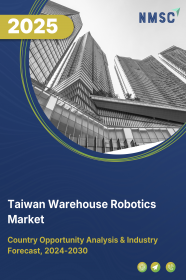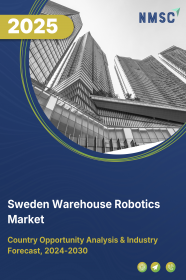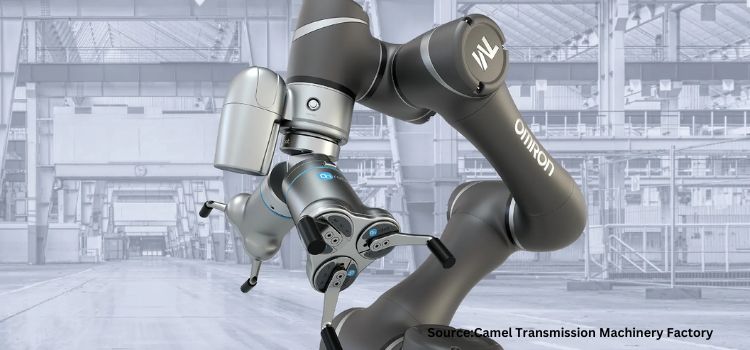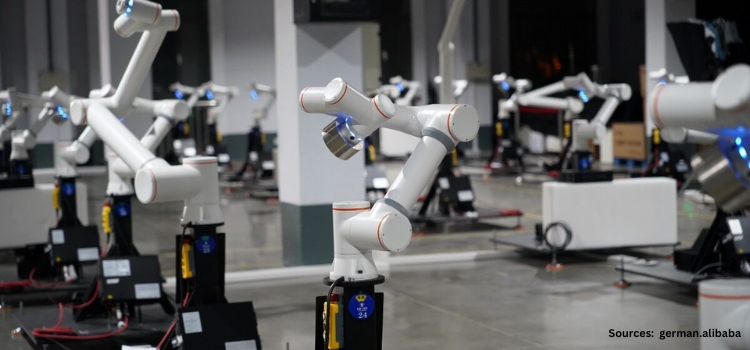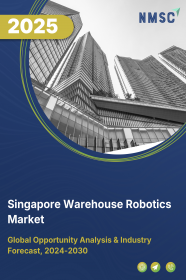
Singapore Warehouse Robotics Market by Type (Automated Guided Vehicles (AGVs), Autonomous Mobile Robots (AMRs), Articulated Robots, & Others), by Offering (Hardware, Software, & Services), by Payload Capacity (Less than 100 KG, 101-200 KG, 201-500 KG, & Others), by Application (Palletizing and Depalletizing, Sorting and Packaging, Picking and Placing, & Transportation) and by End-User (E-commerce, Automotive, Food & Beverages, & Others) – Opportunity Analysis and Industry Forecast, 2025–2030
Industry: Semiconductor & Electronics | Publish Date: 08-Apr-2025 | No of Pages: 224 | No. of Tables: 182 | No. of Figures: 127 | Format: PDF | Report Code : SE3173
US Tariff Impact on Singapore Warehouse Robotics Market
Trump Tariffs Are Reshaping Global Business
Singapore Warehouse Robotics Market Overview
The Singapore Warehouse Robotics Market size was valued at USD 35.3 million in 2024, and is predicted to reach USD 105.4 million by 2030, at a CAGR of 19.0% from 2025 to 2030.In terms of volume, the market size was 2.05 thousand units in 2024 and is projected to reach 6.57 thousand units by 2030, with a CAGR of 20.3% from 2025 to 2030.
Singapore’s labour shortages due to aging population propels the market growth and also expansion of the e-commerce industry acts as a driver for warehouse robotics market. Nevertheless, shortage of skilled professionals is one of the major factors restraining the Singapore warehouse robotics market growth limit the widespread deployment of warehouse robotics industry, reducing overall market growth. On the contrary, introduction of artificial intelligence in the warehouse robotics market creates future option for the market.
Rise in E-Commerce Drives the Singapore Warehouse Robotics Market Trends
The rapid expansion of the e-commerce industry is hugely fueling the need for warehouse robotics. With growing shopping, companies are quickly investing in automation technologies to handle efficiency, simplify operations, and address consumer expectations for quick delivery. According to the latest report presented by ITA, the eCommerce market of Singapore stood at a gross volume of $ 8.2 billion in 2022 and is predicted to grow up to $ 11 billion by the year 2025. Hence, warehouse robotics assists in streamlining inventory management, order fulfilment, and classify procedures and is hence an important factor to support Singapore's changing e-commerce image.
Declining Workforce Demands for Robotics Also Drives the Singapore Warehouse Robotics Market Demand
Due to labour shortages are massively driving the growth of the warehouse robotics market as businesses face challenges such as an aging population and a limited labour force. With increasing difficulty in filling labor-intensive positions, especially in logistics and warehousing, companies are increasingly turning to automation and robotics solutions to address these gaps.
As per the reports from Singapore's Ministry of Manpower, as of September 2024, the labour market remains stiff along with higher rate of unemployment, and a large amount of job vacancies (63,400), showing a continued labour shortage, with a ratio of 1.39 job vacancies for every unemployed person. As robotics technology becomes more affordable and upgraded, companies view these systems as long-term investments that enable sustained growth, making warehouse robotics a key solution to the labour shortage issue in Singapore.
Lack of Skilled Professionals Restraints the Singapore Warehouse Robotics Market Expansion
Adoption of warehouse robotics in Singapore is hindered by a shortage of highly skilled professionals required for maintenance, programming, and troubleshooting of robotic systems. While automation reduces dependence on manual workforce, it creates a growing demand for skilled professionals in automation technology and robotics engineering. The lack of trained personnel with specialized knowledge in areas such as robotic system integration, predictive maintenance, and software optimization poses a massive challenge to businesses intending to apply advanced automation solutions.
Introduction of Artificial Intelligence Creates Future Option for the Market
The addition of artificial intelligence in warehouse robotics is expected to play a major role allowing growth opportunity for the market in the future. AI induced solutions improves decision making, optimize inventory management and improve the accuracy and speed of operations that helps warehouses to become more accurate and adaptable.
As such in January 2025, Nvidia disclosed new AI development tools aimed at improving the potential of autonomous robots and vehicles. These models are mad to create synthetic data and simulate physical interactions, allowing developers to create designed templates for testing their AI systems before real-world. These progresses will focus on the transformative potential of AI in warehouse robotics, paving the way for smarter, more lively and highly efficient warehouse operations that meet the future demands of modern supply chains.
Competitive Landscape
The promising key players operating in the Singapore warehouse robotics industry includes ABB Ltd., Omron Corporation, KUKA AG, Fanuc Corporation, JBT Corporation, Teradyne Inc., Geekplus Technology Co., Ltd., GreyOrange, Locus Robotics, Zebra Technologies, Dematic, Daifuku Co., Ltd., Murata Machinery, Ltd., Yaskawa Electric Corporation, Amazon Robotics LLC and others.
Singapore Warehouse Robotics Market Key Segments
By Types
-
Automated Guided Vehicles (AGVs)
-
Laser Guidance
-
Magnetic Guidance
-
Optical Tape Guidance
-
Vision Guidance
-
Others
-
-
Autonomous Mobile Robots (AMRs)
-
Tow Vehicle
-
Tug Vehicle
-
Unit Load Vehicle
-
Pallet Truck
-
Forklift Vehicle
-
Other Type
-
-
Articulated Robots
-
Collaborative Robots
-
Scara Robots and Cylindrical Robots
-
Others
By Offering
-
Hardware
-
Software
-
Warehouse Management System (WMS)
-
Warehouse Execution System (WES)
-
Warehouse Control System (WCS)
-
-
Services
By Payload Capacity
-
≤ 100 KG
-
101-200 KG
-
201-500 KG
-
501-1000 KG
-
1001-2000 KG
-
2001-5000K
-
More than 5000 KG
By Application
-
Palletizing and depalletizing
-
Sorting and Packaging
-
Picking and Placing
-
Transportation
By End User
-
E-commerce
-
Automotive
-
Food & Beverages
-
Pharmaceutical
-
Chemical and Materials
-
Semiconductor and Electronics
-
Others
Key Players
-
ABB Ltd.
-
Omron Corporation
-
KUKA AG
-
Fanuc Corporation
-
JBT Corporation
-
Teradyne Inc.
-
Geekplus Technology Co., Ltd.
-
GreyOrange
-
Locus Robotics
-
Zebra Technologies
-
Dematic
-
Daifuku Co., Ltd.
-
Murata Machinery, Ltd.
-
YASKAWA ELECTRIC CORPORATION
-
Amazon Robotics LLC
REPORT SCOPE AND SEGMENTATION:
|
Parameters |
Details |
|
Market Size Value in 2024 |
USD 35.3 million |
|
Revenue Forecast in 2030 |
USD 105.4 million |
|
Value Growth Rate |
CAGR of 19.0% from 2025 to 2030 |
|
Market Volume in 2024 |
2.05 thousand units |
|
Unit Forecast in 2030 |
6.57 thousand units |
|
Volume Growth Rate |
CAGR of 20.3% from 2025 to 2030 |
|
Analysis Period |
2024–2030 |
|
Base Year Considered |
2024 |
|
Forecast Period |
2025–2030 |
|
Market Size Estimation |
Million (USD) |
|
Market Volume Estimation |
Thousand units |
|
Growth Factors |
|
|
Companies Profiled |
15 |
|
Market Share |
Available for 10 companies |
|
Customization Scope |
Free customization (equivalent up to 80 working hours of analysts) after purchase. Addition or alteration to country, regional, and segment scope. |
|
Pricing and Purchase Options |
Avail customized purchase options to meet your exact research needs. |

















 Speak to Our Analyst
Speak to Our Analyst




